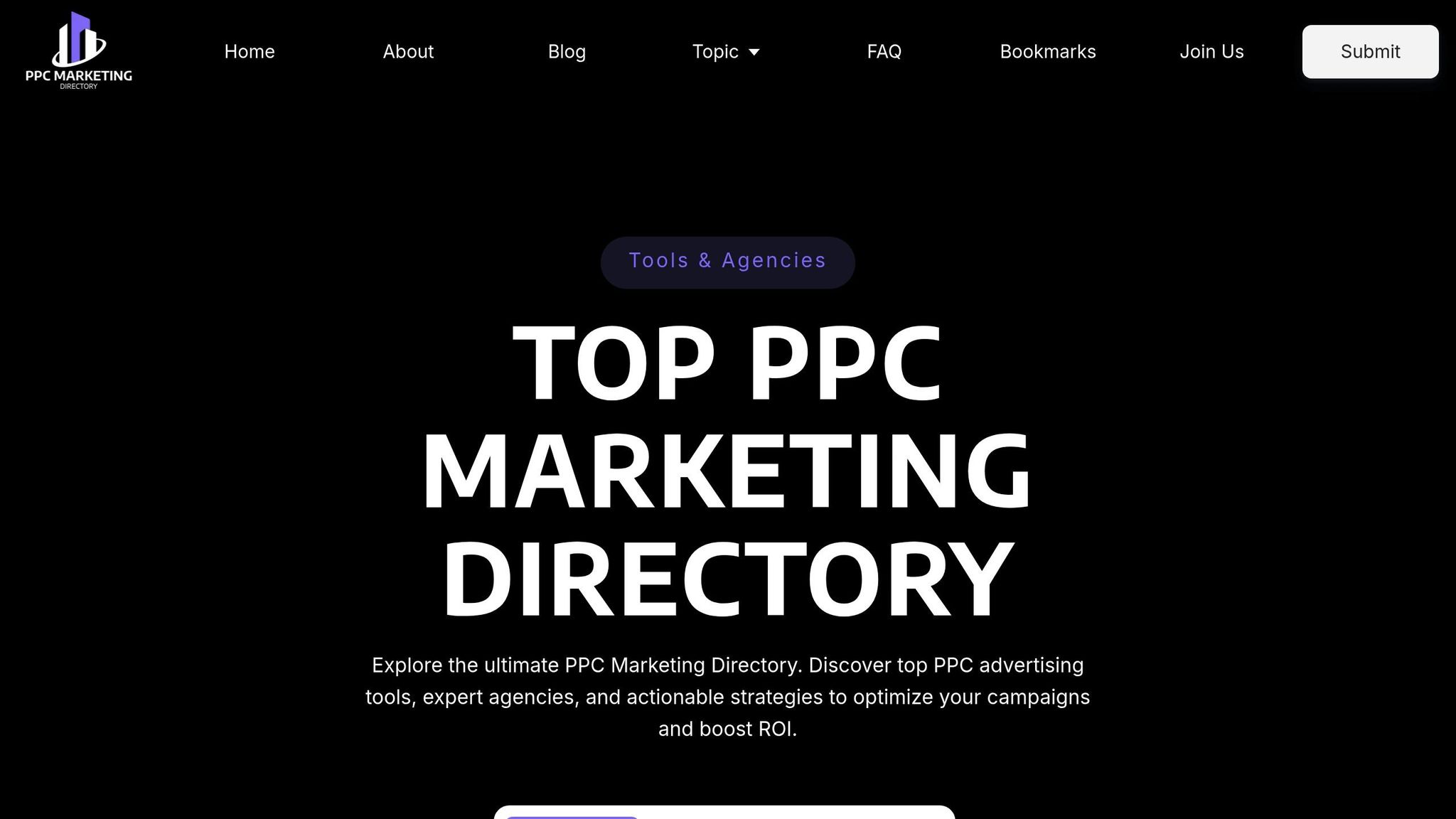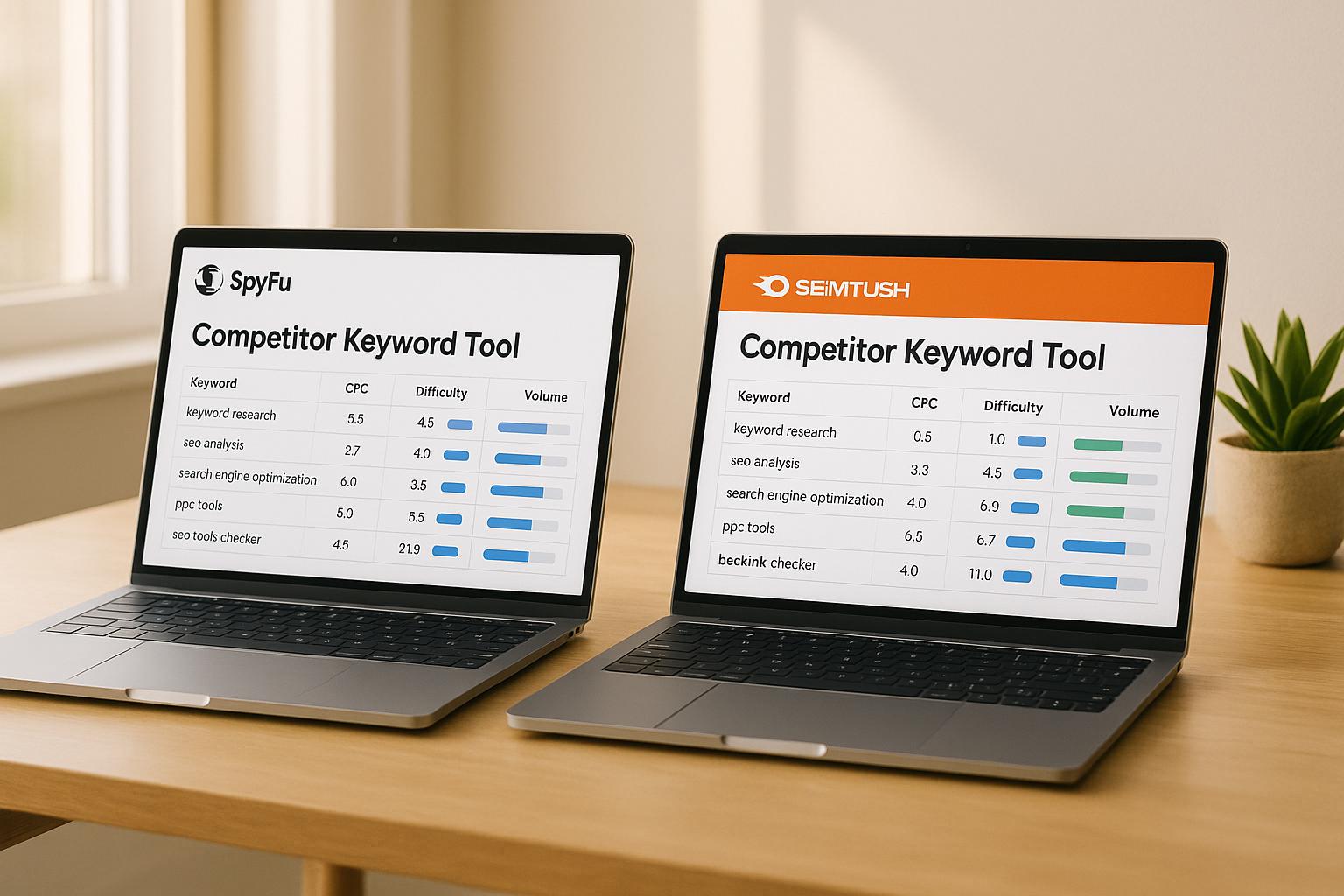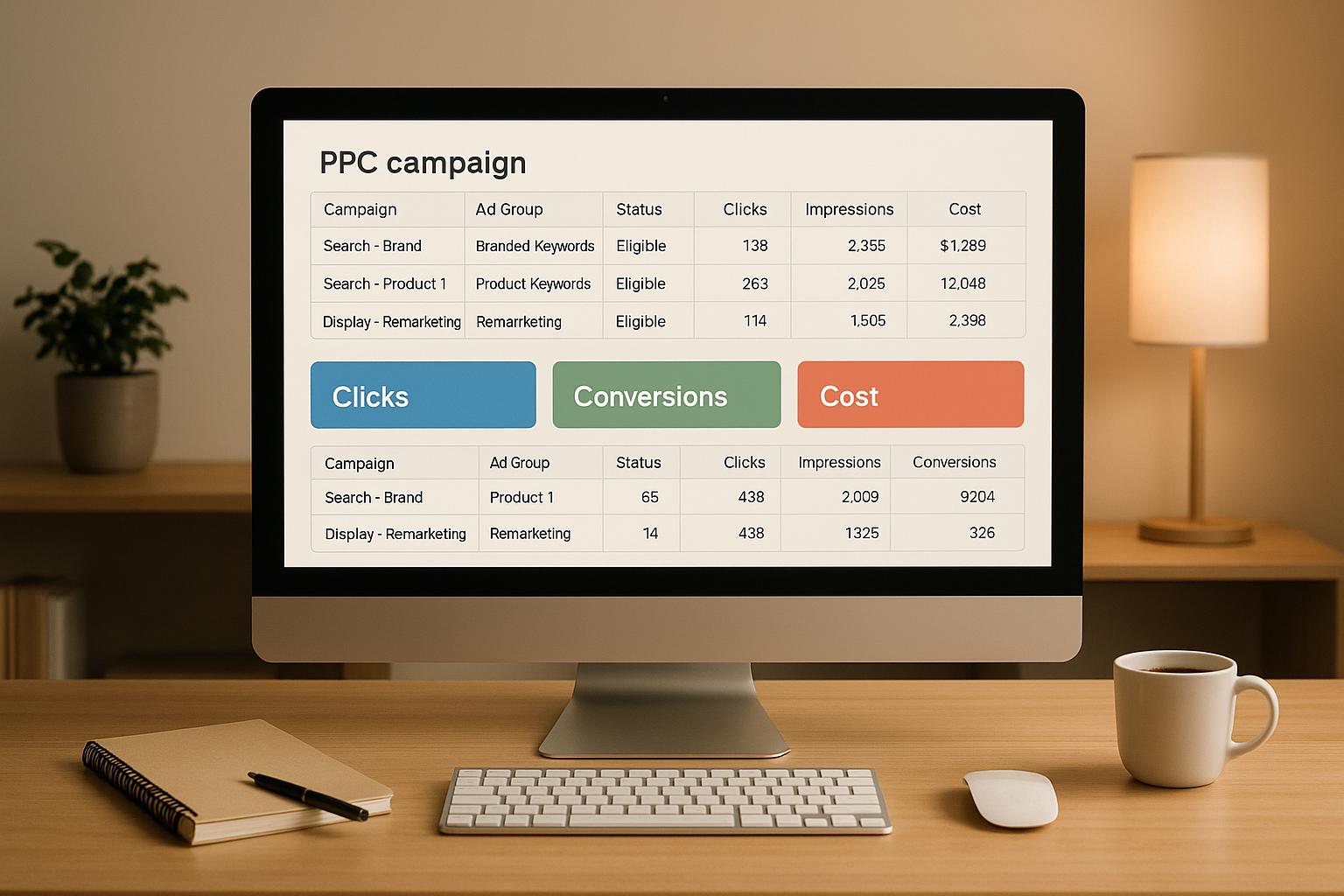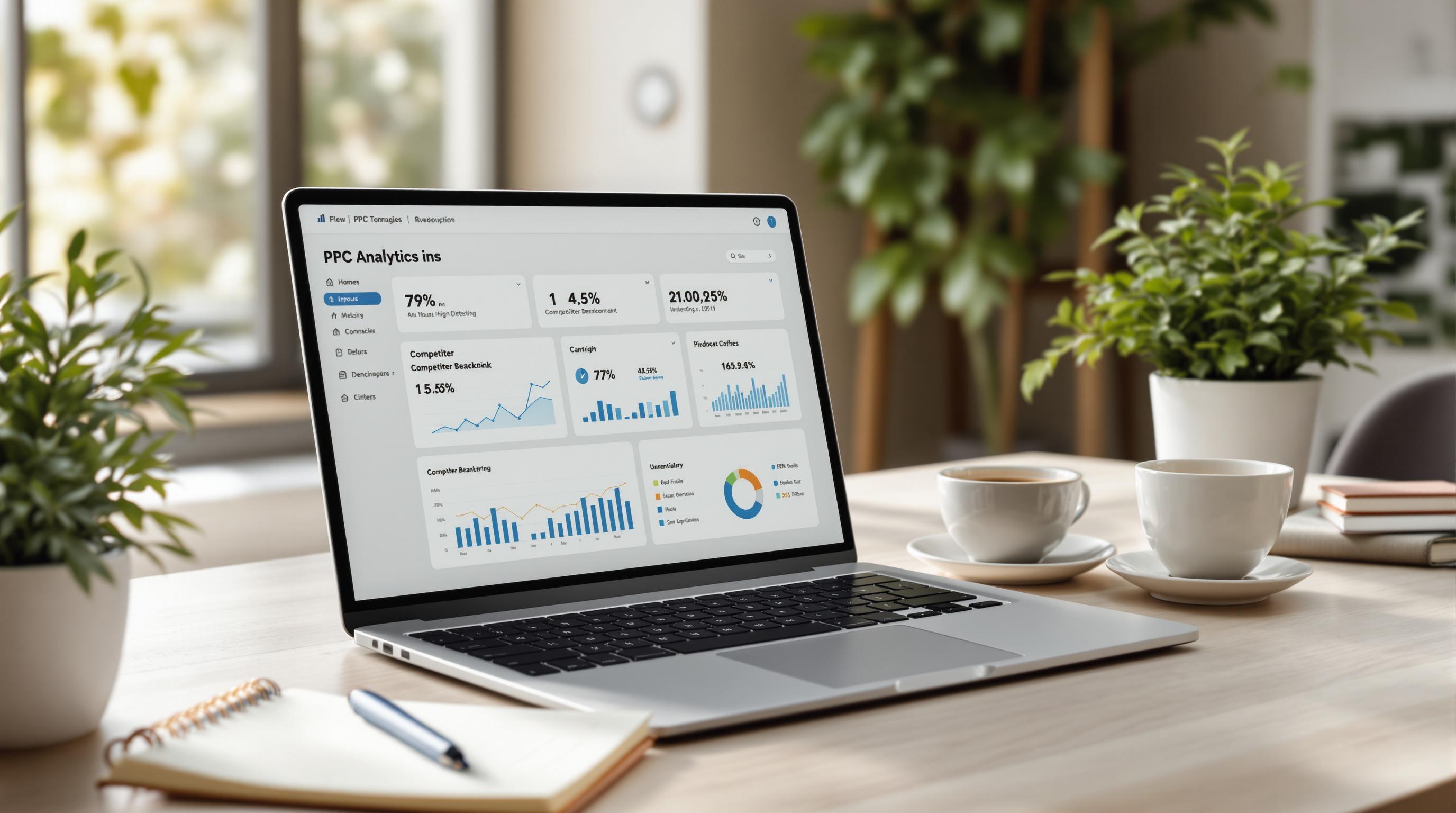Ad relevance directly influences your PPC campaign success by improving your Quality Score, which determines your ad’s placement and cost-per-click (CPC). When your ad aligns with user intent, you get better ad visibility, lower costs, and higher engagement. Here’s what matters most:
- Ad relevance measures how well your ad matches the user’s search intent and keywords.
- Quality Score is based on three factors: ad relevance, expected click-through rate (CTR), and landing page experience.
- Higher ad relevance leads to lower CPCs (up to 59.6% reduction) and better ad rankings.
- Well-targeted ads can increase CTR by up to 220% and improve conversion rates by 15-25%.
To improve ad relevance:
- Use specific keywords and craft tailored ad copy.
- Match your landing page content to your ad’s message.
- Regularly review performance metrics like CTR, search terms reports, and Quality Score ratings.
Better ad relevance means smarter spending and more effective campaigns. Let’s break down how to achieve this.
What Is Ad Relevance and How It Gets Measured
Ad Relevance Definition
Ad relevance is all about how well your ad content aligns with what users are searching for. Think of it as the connection between a user's search query and your ad's copy, keywords, and the overall experience on your landing page.
For instance, imagine someone searches for "best running shoes for marathons" but gets served an ad for casual sneakers. That ad misses the mark because it doesn't address the user's specific need - performance footwear for long-distance running. To truly resonate, your ad has to focus on meeting that precise requirement.
But ad relevance isn’t just about matching keywords. It evaluates the entire experience, including your headline, description, display URL, and the content users encounter after clicking. By ensuring every part of your ad - from the text to the landing page - matches the user's intent, you show that your ad is tailored to their needs.
How Platforms Measure Ad Relevance
Platforms like Google Ads use advanced algorithms to determine how well your ads align with user searches. They don’t just check for exact keyword matches - they analyze semantic relationships. For example, if someone searches for "affordable web design services", Google might find ads mentioning "budget-friendly website development" or "low-cost site creation" to be highly relevant, even though the wording isn’t identical.
Another key factor is user behavior signals. Metrics like click-through rates (CTR) and the time users spend on your landing page after clicking play a big role. If people click your ad and engage with your site, it signals strong relevance. On the other hand, if users quickly bounce back to the search results, it suggests your ad isn’t meeting their expectations.
Relevance scores aren’t fixed - they change over time based on user interactions. This dynamic system ensures that your ad’s performance continues to influence its relevance rating.
Why Ad Relevance Matters for U.S. Advertisers
In the competitive U.S. advertising landscape, ad relevance is a major factor in determining ad placement and return on investment (ROI). Ads that align closely with user intent tend to perform better and cost less.
The financial benefits are clear. Campaigns that focus on matching user intent can see click-through rates increase by up to 220% compared to those that rely solely on keyword relevance. This boost in engagement translates to better results at a lower cost.
Advertisers who prioritize relevance often achieve significant savings. Studies show that optimizing for relevance can reduce cost-per-click (CPC) by an average of 59.6%. For example, if your CPC is currently $2.00, improving ad relevance could bring it down to around $0.81 - without sacrificing visibility.
Relevance also impacts conversion rates. Exact Match keywords, which typically score higher in relevance, tend to deliver conversion rates that are 15-25% higher than Broad Match keywords. This means you’re not just saving on clicks - you’re also attracting traffic that’s more likely to take meaningful actions.
Focusing on ad relevance ensures your advertising dollars are spent wisely. By targeting high-intent users, you minimize wasted spend on irrelevant clicks and maximize the value of your budget. In a market as competitive as the U.S., this approach can mean the difference between a successful campaign and one that drains resources.
Next, we’ll dive into how Quality Score ties into ad relevance and impacts your campaign performance.
Quality Score Components: The 3 Main Factors
The 3 Quality Score Factors
Google's Quality Score is built around three key elements: ad relevance, expected click-through rate (CTR), and landing page experience. While Google doesn’t reveal how much weight each factor carries, all three are essential for running successful PPC campaigns.
- Ad relevance ensures your ad copy matches the intent behind a user’s search. The closer the alignment, the better your chances of engaging the right audience.
- Expected click-through rate (CTR) predicts the likelihood of users clicking on your ad. This estimate is based on historical performance and how your ad compares to others targeting the same keywords. A higher expected CTR means your ad is connecting well with the audience.
- Landing page experience focuses on what happens after someone clicks your ad. This factor considers things like page load speed, mobile usability, content relevance, and how easy the page is to navigate. For example, if your ad promotes a special deal but the landing page doesn’t clearly reflect that offer, your score could take a hit.
These factors work together to shape the effectiveness of your campaign. A well-targeted ad boosts CTR, while an optimized landing page ensures users have a positive experience.
How Quality Score Affects Campaign Results
Quality Score plays a big role in determining both your ad placement and cost-per-click (CPC). Since it’s a key part of Google’s Ad Rank formula, a higher Quality Score can help you achieve better ad positions - even against competitors with higher bids. This often leads to more efficient spending and better campaign outcomes.
How Ad Relevance Impacts Campaign Performance
The Link Between Ad Relevance and Quality Score
Ad relevance plays a key role in boosting your Quality Score, which can improve your ad positions and lower your cost per click (CPC). This creates a ripple effect - better ad placement leads to higher click-through rates (CTR), ultimately driving stronger campaign performance.
Google assesses how well your ad copy aligns with what users are searching for. For instance, if someone types in "running shoes for women" and your ad specifically highlights features tailored to women's athletic footwear, Google identifies this strong match and rewards you with a higher Quality Score.
This gives you an advantage over competitors using more generic ads. Relevant ads can secure better positions at lower costs because Google's Ad Rank formula factors in Quality Score alongside your bid amount. The result? Better ad visibility and smarter spending.
Budget-Friendly Campaign Planning
Focusing on ad relevance doesn't just improve performance - it can save you money. A higher Quality Score often translates into lower CPCs, allowing you to maintain strong ad placements without overspending.
Advertisers who prioritize relevance enjoy reduced bid costs, freeing up resources to expand their keyword coverage or place higher bids during competitive times.
Additionally, strong Quality Scores make it easier to scale campaigns. With better cost control in competitive markets, you can confidently grow your keyword portfolio and reach more potential customers without breaking the bank.
How to Improve Ad Relevance: Step-by-Step Methods
Refine Keywords and Craft Better Ad Copy
The cornerstone of improving ad relevance is targeting the right keywords and aligning them with your ad copy. Think about how your audience searches - your ad should reflect their exact language. For instance, instead of generic terms, use specific phrases like "waterproof hiking boots" to directly address user intent.
Grouping keywords is a practical way to keep things organized. Create small groups of 5-10 related keywords, then tailor your ad copy to fit each group’s intent. For example, if you're targeting "affordable car insurance", make sure your ad headline and description include those exact words instead of vague alternatives like "great auto coverage."
Another way to boost relevance is by using dynamic keyword insertion. This feature automatically inserts the searcher’s exact query into your ad text, making it feel more personalized. But be careful - your ads still need to read smoothly and follow proper grammar. Test both dynamic and static ad versions to figure out which resonates best with your audience.
Don’t overlook ad extensions - they play a big role in relevance. For example, sitelink extensions should lead users to pages directly related to your ad. If your ad promotes "winter coats", your sitelinks should guide users to specific coat categories, not a generic homepage. This ensures a cohesive experience for the user and can improve your relevance score.
With this keyword strategy in place, your ad and landing page messaging will feel more connected and natural.
Align Your Ads with Landing Pages
Consistency between your ad and landing page is key to improving Quality Score. If someone clicks on an ad for "organic dog food", they expect to land on a page all about organic pet nutrition - not a general pet store homepage.
Make sure your landing page headline reinforces the message from your ad. This seamless transition helps users feel like they’re in the right place, which search engines reward. Matching the tone, visuals, and promises in your ad to your landing page further strengthens this connection. For example, ads for professional services should lead to polished, formal landing pages, while casual product ads can link to more relaxed, conversational pages.
Another crucial factor? Speed. Pages that load in under 3 seconds keep users engaged and signal to search platforms that you’re delivering a good experience. A fast, well-matched landing page can make all the difference in keeping visitors on track to convert.
Leverage Tools from the Top PPC Marketing Directory

To keep your campaigns sharp and relevant, take advantage of resources available in the Top PPC Marketing Directory. This platform offers tools and services that can simplify your optimization efforts and help you stay ahead of the competition.
Start with keyword research tools from the directory. These tools can uncover high-intent search terms that your competitors might be missing, giving you an edge in targeting.
Next, look into ad copy optimization services. These tools can help you create more engaging and relevant ad text, often offering A/B testing features so you can compare different versions of your ads. By testing combinations of headlines, descriptions, and calls-to-action, you can pinpoint what works best for your audience.
For ongoing improvement, use performance tracking tools to monitor how your ad relevance evolves over time. These solutions provide insights into what’s working and can alert you when relevance scores dip, so you can make adjustments before your campaign takes a hit.
Lastly, the directory also includes landing page optimization tools to ensure your ads and destination pages are perfectly aligned. These tools can flag inconsistencies and suggest tweaks to make your landing pages more effective.
If you need extra support, many expert agencies listed in the directory specialize in improving Quality Scores and ad relevance. These professionals bring experience from managing campaigns across various industries and can spot opportunities you might miss when handling everything in-house.
sbb-itb-89b8f36
How to Track and Monitor Ad Relevance
Read Ad Relevance Metrics
To get a handle on your ad relevance scores, you need to know where to find them and how to interpret them. In Google Ads, ad relevance is one of the three components of your Quality Score, located in the keywords tab. Your ads are rated as "Above average", "Average", or "Below average" based on how well they align with user searches. If you see a "Below average" rating, it’s a sign that your ad copy might not be connecting with search intent. This often happens when the messaging is too generic or when broad keywords are used without tailoring the content.
Microsoft Ads offers a similar system, but their scoring is more detailed, ranging from 1 to 10. A score below 6 usually signals room for improvement. Microsoft also provides diagnostic insights, which can help pinpoint problems like mismatched keywords or landing page issues.
Another valuable tool is the search terms report, which shows the actual queries that triggered your ads. Reviewing this report can help you spot mismatches. For example, if you’re targeting “digital marketing services” but users are searching for “online marketing help,” this disconnect could lower your relevance scores.
Don’t forget to monitor impression share metrics, as a low impression share often signals poor relevance. Armed with these insights, you’ll be better equipped to refine your strategy and improve performance.
Regular Optimization for Better Results
Consistent optimization is key to staying on top of ad relevance. Establish a weekly review schedule to evaluate your Quality Score components and address any dips in performance.
During these reviews, dive into the search terms report to identify new queries that triggered your ads. Ask yourself if your current ad copy speaks directly to these queries. Adjustments based on this insight can significantly improve your relevance.
Seasonal factors also play a big role in ad relevance. A message that works in one season might fall flat in another. For instance, a tax preparation service would need urgent, deadline-focused ads in March but could shift to early planning and organization themes in September.
On a monthly basis, focus on the lowest-performing 20% of your keywords. Review and refine the headlines and descriptions for these keywords. Often, small changes can elevate a keyword from "Below average" to "Average" or better.
A/B testing should also be part of your regular routine. Run at least two ad variations per ad group for 2-4 weeks to see which messages resonate more effectively. This approach helps you gather enough data to make informed decisions while keeping your tests statistically significant.
Keep an eye on your cost-per-click (CPC) trends alongside relevance scores. Improved ad relevance often leads to lower CPCs. However, if your costs aren’t dropping despite better scores, it could point to broader competitive challenges or issues with other Quality Score elements.
This continuous cycle of monitoring and optimization lays the groundwork for using advanced tools to push your campaigns even further.
Top PPC Marketing Directory Resources
Once you’ve established a solid optimization routine, specialized tools and services can take your efforts to the next level. The Top PPC Marketing Directory is a great resource for finding solutions that streamline your ad relevance monitoring and help you identify opportunities faster.
Here’s how these tools can make a difference:
- Performance tracking tools simplify monitoring by combining Quality Score data with performance metrics in an easy-to-use dashboard. Some even offer automated alerts when relevance scores drop, allowing you to act quickly.
- Competitor analysis tools provide insights into how others in your industry are crafting their ads. If competitors consistently outrank you for certain keywords, their messaging might be better aligned with searcher intent.
- A/B testing services can help you run more complex experiments, testing combinations of headlines, descriptions, and calls-to-action to find the most effective messaging.
- Specialized agencies listed in the directory can offer expert guidance. These agencies bring industry experience and proprietary tools to uncover relevance issues that might be overlooked by in-house teams.
- Landing page optimization tools ensure your destination pages match your ad messaging. These tools can highlight inconsistencies that may be dragging down your relevance scores.
6 Ways to Improve Google Ads Ad Relevance & Quality Score
Conclusion: Why Ad Relevance Matters for PPC Success
Ad relevance isn’t just a number on a dashboard - it’s the backbone of successful PPC campaigns. When your ads align with what users are searching for, everyone wins. Searchers quickly find what they need, and you get higher-quality traffic at a lower cost.
Here’s why it matters: ad relevance directly impacts your Quality Score. A better Quality Score means lower costs per click and higher ad placements. In short, you get more out of your budget while connecting with the right audience. That’s a win-win scenario you can’t afford to overlook.
Improving ad relevance doesn’t have to be complicated. It starts with aligning your keywords, ad copy, and landing pages. Even small changes - like tweaking headlines or rewriting descriptions - can push your scores from "Below average" to "Above average", often leading to significant cost savings.
Tools like the search terms report give you a clearer picture of user intent, helping you fine-tune your strategy. Pair that with A/B testing, and you’ll be able to refine your messaging over time. Regular monitoring ensures these improvements stick and continue to deliver results.
Need extra help? The Top PPC Marketing Directory connects you with specialized tools and expert agencies. Whether you’re looking for advanced tracking, competitor insights, or landing page optimization, the directory offers vetted solutions to elevate your campaigns. By using these strategies, you can ensure your PPC efforts are both effective and competitive.
FAQs
How can I use dynamic keyword insertion to improve ad relevance without lowering ad quality?
To make the most of dynamic keyword insertion (DKI), select keywords that naturally fit your ad's tone and message. This way, the added terms feel seamless and boost relevance without coming across as clunky or out of place. Focus on using DKI in your headlines, and always include fallback text to ensure your ad remains clear and professional if a keyword doesn’t fit perfectly.
Structure your ad groups around closely related themes. This approach keeps the inserted keywords relevant and prevents your ads from feeling disconnected, which could hurt your Quality Score. Striking a balance between relevance and readability is key to crafting effective, engaging ads that perform well.
What mistakes can lower your ad relevance score, and how can you avoid them?
A low ad relevance score usually stems from mismatched targeting, unclear messaging, or a disconnect between your ad content, user intent, and the landing page. These missteps can leave users puzzled and less likely to engage.
To tackle this, prioritize accurate audience targeting, write concise and relevant ad copy, and make sure your landing page delivers on the promises in your ad. Keep an eye on your campaign’s performance to spot and fix any weak points or inconsistencies. Sharpening these elements can boost your ad relevance and enhance the success of your campaigns.
How does matching your ad copy with your landing page content affect Quality Score and campaign performance?
Ensuring your ad copy closely matches the content of your landing page can significantly influence your Quality Score and the overall success of your campaign. When Google detects this alignment, it views your ad as highly relevant, which can boost your Quality Score (on a scale of 1 to 10). A higher score often leads to perks like lower cost-per-click (CPC), improved ad placements, and increased click-through rates.
But the benefits don’t stop there. Consistency between your ad and landing page also creates a better user experience by delivering on the expectations set in your ad. This can lower bounce rates, drive more conversions, and help you make the most of your ad budget. Prioritizing relevance is a smart way to enhance performance across the board and get better results from your campaigns.


